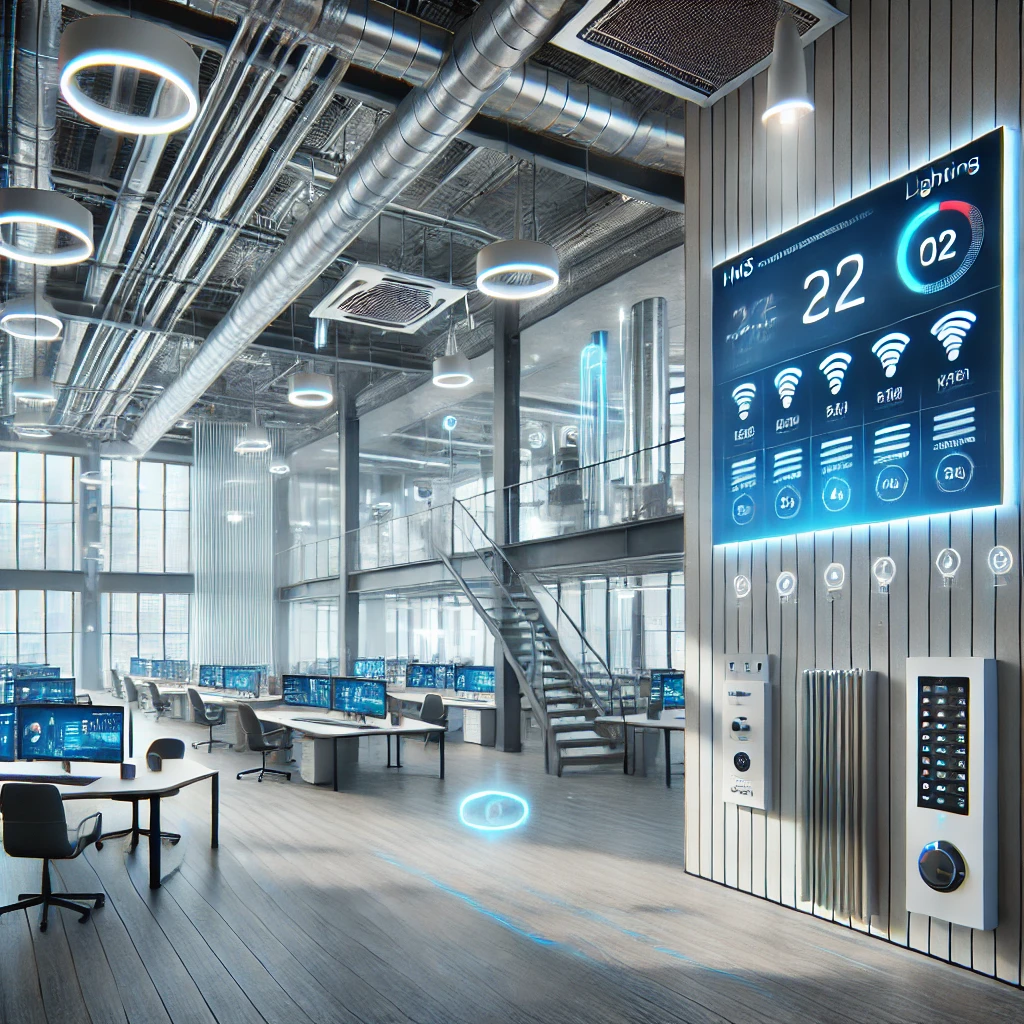By Aplha Controls LDN
In modern commercial buildings, achieving energy efficiency and occupant comfort hinges on the effective management of two critical systems: HVAC (Heating, Ventilation, and Air Conditioning) and lighting. These systems account for a significant portion of a building’s energy consumption, making their optimisation essential. This is where Building Management Systems (BMS) come into play, serving as the nerve centre for controlling and monitoring these functions.
In this article, we’ll explore how BMS optimises HVAC and lighting systems, contributing to energy efficiency, cost savings, and environmental sustainability.
Table of Contents
- What is a Building Management System (BMS)?
- Why Optimising HVAC and Lighting is Essential
- How BMS Optimises HVAC Systems
- How BMS Optimises Lighting Systems
- Benefits of Using BMS for HVAC and Lighting Optimisation
- Conclusion
What is a Building Management System (BMS)?
A Building Management System (BMS) is a centralised platform that automates, monitors and controls a building’s critical operations, including HVAC and lighting systems. By using sensors, controllers, and advanced software, a BMS ensures systems operate efficiently, maintaining occupant comfort while minimising energy consumption.
Why Optimising HVAC and Lighting is Essential
In commercial buildings, HVAC and lighting systems are responsible for 60–70% of total energy consumption. Inefficient operations in these systems can lead to:
- Excessive energy waste.
- Higher operational costs.
- Reduced equipment lifespan.
- Increased carbon footprint.
Optimising these systems is critical for achieving sustainability goals, meeting energy regulations, and maintaining tenant satisfaction.
How BMS Optimises HVAC Systems
1. Demand-Driven Operation
A BMS uses real-time data from sensors to adjust HVAC systems based on current demand. For example:
- In low-occupancy periods, the BMS reduces HVAC output to conserve energy.
- During peak hours, the system adjusts to maintain comfort without overloading.
This demand-driven approach eliminates unnecessary energy use while maintaining indoor air quality and temperature.
2. Predictive Maintenance
BMS technology incorporates fault detection and diagnostics (FDD) to monitor HVAC performance continuously. By identifying issues such as inefficient airflows or refrigerant leaks early, it prevents:
- Unexpected breakdowns.
- Energy losses due to suboptimal performance.
- High repair costs from prolonged equipment wear.
3. Zone-Based Temperature Control
Modern BMS systems enable zoning, where different building areas are maintained at different temperatures based on occupancy and usage. For example:
- Conference rooms can have active cooling during meetings but switch to standby when vacant.
- Warehouses may require minimal heating compared to office spaces.
This targeted control minimises energy use in unoccupied zones.
How BMS Optimises Lighting Systems
1. Smart Scheduling
BMS allows facility managers to pre-program lighting schedules based on business hours or seasonal changes. Key benefits include:
- Automatic on/off functionality: Lights turn on only when needed.
- Energy savings during downtime: Eliminates unnecessary usage in after-hours or low-traffic areas.
2. Occupancy-Based Control
Occupancy sensors integrated with BMS systems detect motion in a room and adjust lighting accordingly. For example:
- Lights automatically turn off in unused meeting rooms.
- Hallway lights dim during off-peak hours but brighten when motion is detected.
This functionality significantly reduces energy waste while maintaining convenience.
3. Daylight Harvesting
Daylight harvesting uses sensors to measure natural light levels and adjust artificial lighting to complement it. For example:
- In areas near large windows, lights dim automatically during sunny hours.
- In cloudy weather, lighting intensity increases to maintain visibility.
This technique not only saves energy but also enhances occupant comfort by reducing glare and creating a balanced indoor environment.
Benefits of Using BMS for HVAC and Lighting Optimisation
Implementing a BMS to optimise HVAC and lighting systems offers multiple advantages:
- Energy Efficiency: Reduced energy consumption translates to lower utility bills.
- Enhanced Comfort: Ensures temperature and lighting levels are always ideal for occupants.
- Extended Equipment Lifespan: Regular monitoring and predictive maintenance reduce wear and tear.
- Compliance: Helps meet energy efficiency standards and green building certifications like LEED and BREEAM.
- Data Insights: Provides actionable analytics to fine-tune building operations.
Conclusion
A Building Management System (BMS) plays a crucial role in optimising HVAC and lighting systems, ensuring that commercial buildings achieve energy efficiency without compromising comfort. By leveraging features like demand-driven operation, smart scheduling, and daylight harvesting, a BMS helps facility managers reduce costs, enhance sustainability, and create a more adaptable building environment.
As energy efficiency and sustainability continue to gain importance, investing in a robust BMS is no longer optional—it’s a necessity.


0 responses to “The Role of BMS in Optimising HVAC and Lighting Systems”